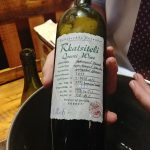
Wines from Georgia may not be a household name yet (in the U.S. at least) but if the white wines I sampled during the Wines of Georgia Tasting Event in New York City is any indication of what this region has to offer (and it was pretty comprehensive), they should be.
First a few technical points about Georgian wine. The region has an 8000 year old history of winemaking, around 500 indigenous grapes (international varietals like Cabernet Sauvignon are cultivated as well) and comprises 10 wine producing areas including Abkhazia, Samegrelo, Guria, Adjara, Imereti, Meskheti, Lechkhumi, Racha, Kartli and Kakheti. Most wine growing vines in Europe have their provenance in Georgia and even the ancient Greeks and Romans sung the praises of Georgian wines and vines.
The landscape runs the gamut from coastal (by the Black Sea) and mountainous (with elevations as high as 900 to 1700 meters above sea level), to lush valleys, winding slopes, and basins along the Rioni and the Mtkvari rivers. Warm summer days and cool nights as well as microclimates make the region conducive to growing a multitude of varietals.

Now onto wine production. When we talk about winemaking methods today we usually refer to stainless steel tank or oak barrel wine fermentation and aging. While Georgian winemakers use both of these wine producing practices to create wines they also employ the ancient Georgian practice of using qvevri, also known as churi – beeswax lined earthenware jars -to ferment and age their wines. White wines produced using qvevri tend to take on a deeper color than those produced in stainless steel tanks or oak barrels because they remain in contact with their skins far longer. They take on an orange tone and are referred to as orange wines.
Traditionally, qvevri were primarily stored in wine cellars but excess pressure resulting from naturally occurring yeasts during the fermentation process made it more practical to bury the qvevri in the ground. The cooler temperatures underground allow the juice to ferment longer. The distinct concentrated flavor of wines produced using qvevri is unmistakable and heightened by the prolonged contact of the juice with their skins.
Now onto the varietals. Learning about 500 grapes at once is a daunting task so let’s touch on a few of the main whites.

Rkatsiteli. This white grape makes up 43 percent of wine production and is planted across Georgia’s 20,000 hectares of wine growing country. The grape is characterized by floral aromas, fresh notes of citrus and green apple, and acidity. It is often blended with Mtsvane Kakhuri, another white grape, to mellow out its acidity while enhancing its inherent floral and fruity characteristics.
Mtsvane Kakhuri, often blended with Rkatsiteli (as mentioned previously), ripens before Rkatsiteli and is also characterized by high acidity and sugar levels. It is frequently used to make fortified and sweet wines. Wines produced using Mtsvane Kakhuri exhibit orchard and citrus fruit aromas, ripe peach, apricot and papaya notes and a subtle minerality. These elements are even more pronounced when the wine is vinified in qvevri.
Tsolikouri has high yields and tends to mature in autumn around the middle of October. This white varietal produces wines with herbal and floral aromas, balanced lemon, cantaloupe and honeydew notes, and a measure of minerality. Oak barrel fermentation adds soft vanilla and cream notes. This white varietal responds well to aging.
Tsitska is also characterized by high yields but it usually matures a few weeks before Tsolikouri. Wines made from Tsitska exhibit lemon, apple, pear, and soft honey notes. Tsitska can also be blended with other varietals including Tsolikouri and Krakhunato. Tsitska is also used to make sparkling wine.
Chinuri exhibits high natural levels of acidity and is used to produce sparkling or still white wines. This crisp grape is sometimes combined with Goruli Mtsvane or Aligoté. Chinuri is characterized by orchard fruit, chamomile and cool mint aromas, and ripe pear, peach and apricot notes. Chinuri produced using qvevri heightens these elements.
Some Georgian white wines to consider:
Marani Kondoli (50 percent Mtsvane, 50 percent Kisi)
Mosmieri Kakhuri Domaine Matthies (100 percent Rkatsiteli)
Makashvili Mtsvane (100 percent Khikhvi)
Iberiuli Tsinandali (85 percent Rkatsiteli, 15 percent Mtsvane)
Pheasant’s Tears (100 percent Rkatsiteli)
Tarasi Minadze Phersvi (100 percent Tsolikauri)
Velistsikhe Veranda (100 percent Rkatsiteli)

Tbilvino Georgian Valleys (100 percent Rkatsiteli)
Akhmeta Wine House (100 percent Mtsvane Kakhuri)
Baia’s Wine (100 percent Tsolikouri)


Be First to Comment